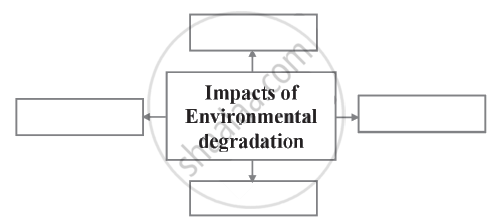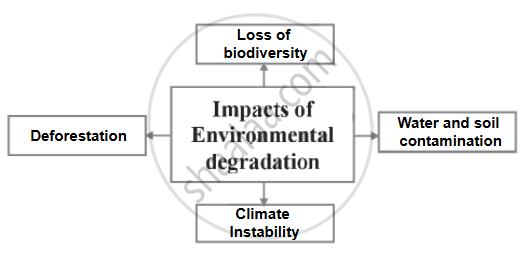Advertisements
Advertisements
प्रश्न
Read the following extract and complete the activities given below:
|
My inspiration comes from my childhood experiences and observations of nature in rural Kenya. As I was growing up, I witnessed forests being cleared and replaced by commercial plantations, which destroyed local biodiversity and the capacity of the forests to conserve water. In 1977, when we started the Green Belt movement, I was partly responding to the needs. identified by rural women, namely lack of firewood, clean drinking water, balanced diets, shelter, and income. Throughout Africa, women are the primary caretakers, holding significant responsibility for tilling the land and feeding their families. As a result, they are often the first to become aware of environmental damage as resources become scarce and they are incapable of sustaining their families. The women we worked with recounted that, unlike in the past, they were unable to meet their basic needs. This was due to the degradation of their immediate environment as well as the introduction of commercial farming, which replaced the growing of household food crops. But international trade controlled the price of the exports from these small-scale farmers, and a reasonable and just income could not be guaranteed. I came to understand that when the environment is destroyed, plundered or mismanaged, we undermine the quality of our life and that of future generations. Tree planting became a natural choice to address some of the initial basic needs identified by women. Also, tree planting is simple, attainable and guarantees quick, successful results within a reasonable amount of time. This sustains interest and commitment. Together, we have planted over 30 million trees that provide fuel, food, shelter, and income to support our children’s education and household needs. The activity also creates employment and improves soil and watersheds. Initially, the work was difficult because they were unaware that a degraded environment leads to a scramble for scarce resources and may culminate in poverty and even conflict. They were also unaware of the injustices of international economic arrangements. Later, they became aware of the widespread destruction of the ecosystems, especially through deforestation, climatic instability and contamination of the soil and waters - all contributed to excruciating poverty and subsequent riots. |
A1. Complete the web diagram on ‘the impacts of environmental degradation’: (2)

A2. Provide the supporting details from the extract that highlight the positive effects of tree plantation: (2)
| Positive effects | (1) |
| of | (2) |
| tree plantation | (3) |
| (4) |
A3. Environmental degradation and mismanagement affect the life in rural Kenya. Explain. (2)
A4. Suggest some ways to protect your local environment. (2)
A5. Language Study: (2)
Do as directed:
(i) Tree planting became a natural choice.
(Find out the correct option in which ‘Present Perfect Tense’ is used.)
(a) Tree planting had become a natural choice.
(b) Tree planting has become a natural choice.
(c) Tree planting will become a natural choice.
(d) Tree planting has been become a natural choice.
(ii) They were unable to meet their basic needs.
(Choose the correct ‘Negative sentence’ of the given statement from the options given below and write it.)
(a) They are not able to meet their basic needs.
(b) They have not able to meet their basic needs.
(c) They were not able to meet their basic needs.
(d) They will not be able to meet their basic needs.
A6. Vocabulary: (2)
Find out the words from the extract which mean-
(a) extremely painful
(b) all forms of life on earth
(c) act of stealing/removing
(d) the action of making impure by polluting
उत्तर
A1.
A2.
| Positive effects | (1) Provides fuel, food, shelter, and income |
| of | (2) Supports children’s education and household needs |
| tree plantation | (3) Creates employment opportunities |
| (4) Improves soil and watersheds |
A3. Environmental degradation and mismanagement negatively impact rural Kenya in various ways:
- Scarcity of resources: Rural communities face a shortage of firewood, clean drinking water, and food.
- Economic hardship: Commercial farming replaces household food crops, making small-scale farmers struggle.
- Environmental damage: Deforestation and water pollution worsen the living conditions.
- Increased poverty and conflicts: Lack of resources leads to economic instability and even riots.
A4.
- Plant more trees to prevent deforestation and improve air quality.
- Reduce plastic use and encourage recycling to prevent pollution.
- Use water efficiently and prevent contamination of natural water bodies.
- Promote sustainable farming practices to maintain biodiversity.
- Spread awareness about the importance of environmental conservation.
A5.
(i) Tree planting has become a natural choice.
(ii) hey were not able to meet their basic needs.
A6.
(a) extremely painful − Excruciating
(b) all forms of life on earth − Biodiversity
(c) act of stealing/removing − Plundered
(d) the action of making impure by polluting − Contamination
